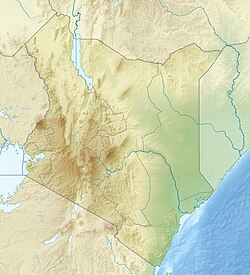
Nairobi
Capital and largest city of Kenya / From Wikipedia, the free encyclopedia
Dear Wikiwand AI, let's keep it short by simply answering these key questions:
Can you list the top facts and stats about Nairobi?
Summarize this article for a 10 year old
Nairobi (/naɪˈroʊbi/ ny-ROH-bee) is the capital and largest city of Kenya. The name is derived from the Maasai phrase Enkare Nairobi, which translates to 'place of cool waters', a reference to the Nairobi River which flows through the city. The city proper had a population of 4,397,073 in the 2019 census.[7][8] The city is commonly referred to as The Green City in the Sun.[9]
Nairobi | |
|---|---|
 Clockwise from top: central business district; a giraffe walking in Nairobi National Park; Parliament of Kenya; Nairobi City Hall; and the Kenyatta International Convention Centre | |
| Nickname: "The Green City in the Sun" | |
| Coordinates: 01°17′11″S 36°49′02″E | |
| Country | |
| County | Nairobi City |
| Founded | 1899; 125 years ago (1899) |
| Sub-counties | |
| Government | |
| • Body | Nairobi City County |
| • Legislature | County Assembly |
| • Governor | Johnson Sakaja |
| Area | |
| • Consolidated city-county | 696.1 km2 (268.8 sq mi) |
| Elevation | 1,795 m (5,500 ft) |
| Population (2019)[3] | |
| • Consolidated city-county | 4,397,073 |
| • Estimate (2024)[4] | 4,828,000 |
| • Density | 6,317.6/km2 (16,363/sq mi) |
| • Urban | 4,397,073 |
| Demonym | Nairobian |
| Time zone | UTC+3 (EAT) |
| Area code | 020 |
| HDI (2019) | 0.681[5] - medium |
| GDP (2023) | 30 billion USD[6] |
| GDP PPP (2023) | 90 billion USD[6] |
| Website | nairobi |
Nairobi is home of the Kenyan Parliament Buildings and hosts thousands of Kenyan businesses and key international companies and organizations, including the United Nations Environment Programme (UN Environment) and the United Nations Office at Nairobi (UNON). Nairobi is an established hub for business and culture. The Nairobi Securities Exchange (NSE) is one of the largest stock exchanges in Africa and the second-oldest exchange on the continent. It is Africa's fourth-largest stock exchange exchange in terms of trading volume, capable of making 10 million trades a day. It also contains the Nairobi National Park. Nairobi joined the UNESCO Global Network of Learning Cities in 2010.
Nairobi was founded in 1899 by colonial authorities in British East Africa, as a rail depot on the Uganda - Kenya Railway. It was favoured by the authorities as an ideal resting place due to its high elevation, temperate climate, and adequate water supply.[10] The town quickly grew to replace Mombasa as the capital of Kenya in 1907.[11]
After independence in 1963, Nairobi became the capital of the Republic of Kenya.[12] During Kenya's early period, the city became a centre for the coffee, tea and sisal industries.[13][14] The city lies in the south central part of Kenya, at an elevation of 1,795 metres (5,889 ft).




